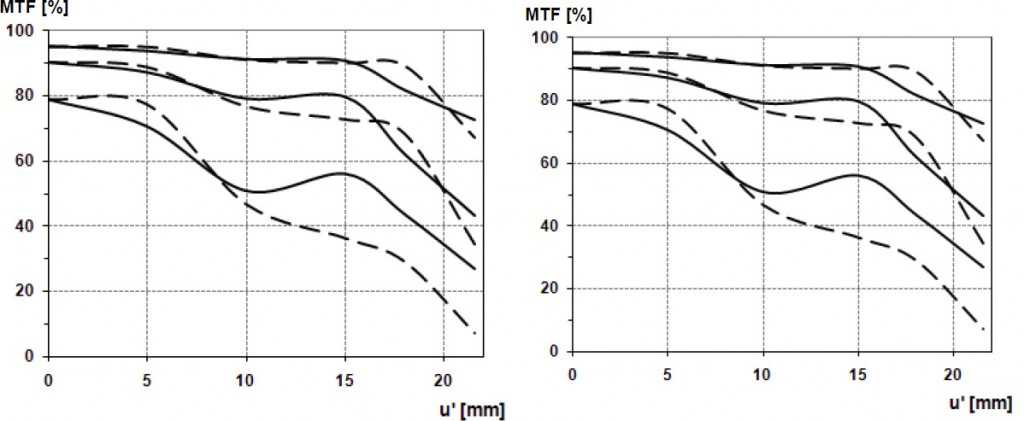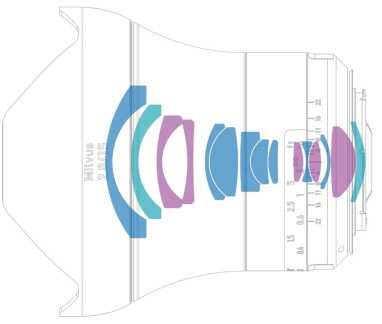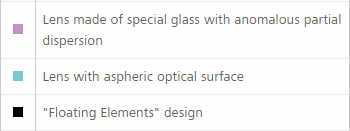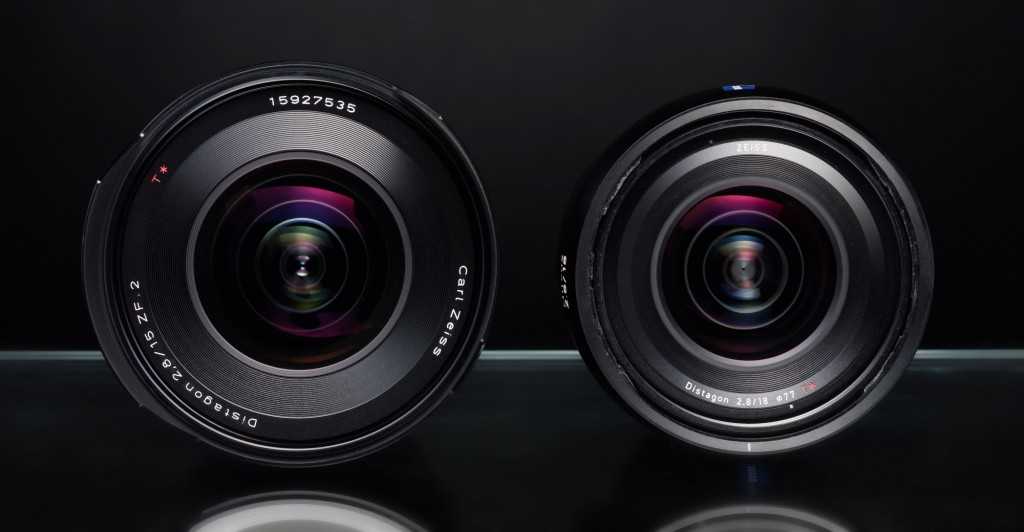Reasons to Buy Carl Zeiss Distagon T 2,821 Lens
Here we’ve included a summary of the advantages and disadvantages of the Carl Zeiss Distagon T 2,821 lens in a list form to help you determine whether it offers the features you need.
PROs
| Aperture Ring |
| Distance Scale |
| DoF(Depth of Field) Scale |
| Hood supplied |
| Covers Full-Frame Sensor |
| Minimum focus distance of 0.22m / 8.7 inch |
Report a correction
Buy Carl Zeiss Distagon T2,8/21 from or B&H PHOTO
CONs
| No Autofocus |
Lens Mount
Carl Zeiss Distagon T2,8/21 is compatible with cameras that have a Canon EF lens mount. Some of the latest released cameras that are compatible with the Canon EF lenses are Canon 1D X III, Canon 6D MII and Canon 5D MIV.
Carl Zeiss Distagon T2,8/21 is also available in Pentax KAF and Nikon F (FX) mounts.
Size, Weight and Filter Thread
Size and weight is a very important decision factor when searching for your next lens. Carl Zeiss Distagon T2,8/21 has a maximum diameter of 87mm and total length of 109mm. It weighs 600g / 21.2 oz.
Carl Zeiss Distagon T2,8/21 has a filter thread of 82mm. Below are links to the filters that we recommend you to consider for your Carl Zeiss Distagon T2,8/21:
Optical Image Stabilization
Carl Zeiss Distagon T2,8/21 doesn’t have an optical image stabilization system so the only option to stabilize the image taken with this lens is to mount on a camera body with IBIS (sensor based In-body image stabilization).
Alternatively, you can check the Canon 24mm f2.8 IS USM in Canon EF mount that have similar focal range but features Optical Image Stabilization.
Lenses Similar to Carl Zeiss Distagon T2,8/21 With Optical Image Stabilization
| Model | Coverage | Weight | Focusing | Street Price | |
|---|---|---|---|---|---|
|
Canon EF 24mm f2.8 IS USM Compare |
35mm FF | 280gr | AF |
Maximum Magnification Ratio
Carl Zeiss Distagon T2,8/21 has a Max Magnification Ratio of 0.2x and has a minimum focusing distance of 0.22m.
Below are the 3 Wideangle Prime type Canon12 mount lens alternatives with highest max magnification ratios:
- Tamron 35mm F1.8 Di VC USD: 0.4x — (Compare)
- Canon 35mm f2 IS USM: 0.24x — (Compare)
- Canon 24mm f2.8 IS USM: 0.23x — (Compare)
Lens Hood
Carl Zeiss Distagon T2,8/21 comes with a removable lens hood which is handy to reduce lens flare and glare in your photos.
Popular Comparisons of Carl Zeiss Distagon T2,8/21
Top Alternatives of Carl Zeiss Distagon T2,8/21 Lens
| Model | Coverage | Weight | Focusing | Street Price | |
|---|---|---|---|---|---|
|
Zeiss Milvus 25mm F1.4 Compare |
35mm FF | 1,225 g / 2.70 lb | MF | ||
|
Voigtlander 20mm F3.5 Color Skopar SL II Compare |
35mm FF | 205 g / 0.45 lb | MF | ||
|
Sigma 20mm F1.4 DG HSM A Compare |
35mm FF | 950 g / 2.09 lb | AF | ||
|
Canon EF 24mm f1.4L II USM Compare |
35mm FF | 650 g / 1.43 lb | AF | ||
|
Zeiss Milvus 18mm F2.8 Compare |
35mm FF | 721 g / 1.59 lb | MF | ||
|
Canon EF 20mm f2.8 USM Compare |
35mm FF | 405 g / 0.89 lb | AF | ||
|
Samyang 20mm F1.8 ED AS UMC Compare |
35mm FF | 497 g / 1.09 lb | MF | ||
|
Canon EF 24mm f2.8 Compare |
35mm FF | 270 g / 0.59 lb | AF |
The Accessible One

21mm, however, is within what I call the landscape photographers “sweet spot” between 18 and 22mm. It makes for a very natural landscape or wide angle composition. I have a 12mm Rokinon prime for mirrorless bodies that I really love, as 12mm on a crop (Canon’s is 1.6x) falls also within this sweet spot. It is just a very natural and easy focal length to use. The less extreme nature of the focal length also means that this lens is both easier to engineer and more accessible to use. Here a few examples when compared to the Distagon 15mm:
- Price: the 21mm currently retails at B&H Photo for $1843; the 15mm for $2950
- Size: the 21mm is 4.29”/109mm and 600g ; the 15mm is 5.31”/135mm and 820g
- Design: the 21mm has a traditional removable lens hood and lens cap; the 15mm has a fixed lens hood and a large lens cap that fits over the lens hood.
- Front Filter: the 21mm uses a large but fairly common 82mm filter (I have a number of them already); the 15mm uses a much larger, rarer, and more expensive 95mm filter.
The tradeoff is that the wider focal length can produce uniquely dramatic images when used correctly that the less extreme 21mm cannot. But many photographers will find the 21mm a more natural choice for some or all of the reasons above.
Технические характеристики
| Carl Zeiss Distagon 15/2.8 | ZEISS Milvus 15/2.8 | |
|---|---|---|
| Фокусное расстояние | 15 мм | 15 мм |
| Диапазон значений диафрагмы | f2.8-f22 | f/2,8 – f/22 |
| Оптическая схема (элементов/групп) | 15/12 | 15/12 |
| Оптическая стабилизация | нет | нет |
| Диапазон фокусировки | 0,25 м – ∞ | 0,25 м – ∞ |
| Рабочий диапазон | 0,09 м – ∞ | 0,09 м – ∞ |
| Углы обзора (диаг./гориз./верт.) | 110° / 100° / 76° | 110° / 100° / 76° |
| Диаметр круга покрытия | 43 мм | 43 мм |
| Рабочий отрезок | ZF.2: 46,50 мм ZE: 44,00 мм |
ZF.2: 46,50 мм ZE: 44,00 мм |
| Покрытие на МДФ | 340 x 221 мм | 340 x 221 мм |
| Масштаб на МДФ | 1:9 | 1:9 |
| Диаметр резьбы под фильтр | M95 x 1.0 | M95 x 1.0 |
| Положение входного зрачка (за плоскостью изображения) | 112,6 мм | 112,6 мм |
| Угол вращения фокусировочного кольца (от ∞ до МДФ) | 57° | 119° |
| Максимальный диаметр (с блендой) | ZF.2, ZE:103,0 мм | ZF.2, ZE:102,3 мм |
| Диаметр фокусировочного кольца | ZF.2, ZE: 80,0 мм | ZF.2, ZE: 80,0 мм |
| Длина (без крышек) | ZF.2: 113,0 мм ZE: 116,0 мм |
ZF.2: 99,0 мм ZE: 100,2 мм |
| Длина (с крышками) | ZF.2: 132,0 мм ZE: 135 мм |
ZF.2: 114,0 мм ZE: 117,0 мм |
| Вес | ZF.2: 730 гр. ZE: 820 гр. |
ZF.2: 880 гр. ZE: 947 гр. |
Самая первая альтернатива это ZEISS Milvus 15/2.8. Это тот же объектив, но в новом корпусе с влагозащитой.
Вот график MTF, который очень наглядно показывает что это один объектив. Даже подписывать не стал где какой ![]()

Также они делят на двоих оптическую схему.


В спецификации Carl Zeiss Distagon 15/2.8 типы элементов подписаны не были, а в спецификации ZEISS Milvus 15/2.8 мы имеем более полную информацию.
5 низкодисперсионных элементов
2 асферических элемента
В целом, сложный и дорогой в плане себестоимости объектив.
Как видите из таблицы с параметрами, между Carl Zeiss Distagon 15/2.8 и ZEISS Milvus 15/2.8 всё-таки есть небольшие отличия. Главное отличие ход фокусировочного кольца, который у ZEISS Milvus 15/2.8 значительно больше. Также ZEISS Milvus 15/2.8 короче, меньше и легче. Но диаметр передней линзы у них одинаковый и потому максимальный диаметр тоже одинковый.
Conclusion
Please enable JavaScript
Zeiss Distagon T* 2.8/21mm Wide Angle Lens Review
In conclusion, you can probably tell that using the Zeiss Distagon T* 2.8/21mm has been a joy for me. I know as a photographer when I am reviewing a Zeiss lens that I am going to get a number of images that are going to be special. I know as a lens reviewer and lover of fine gear that I am going to get to use a piece of gear that is finely tooled and crafted and will be a genuine joy to use. The Distagon 21mm is all of these things. It is also very accessible in both its focal length and its ease of use despite being a manual focus lens. If you have never used a manual focus lens, this may be one of the easiest places to start. If you have never experienced the exceptional quality of the images captured with a Zeiss lens, then this is also a great place to start. Zeiss lenses have their own unique set of drawbacks that I have tried to detail above, but there is an indefinable joy in using them as well. If you don’t need the more extreme focal length provided by the Distagon 15mm and want Zeiss quality, the Distagon 21mm is a more accessible option that will satisfy you again and again with great image quality.
Build and Handling
The Zeiss Distagon T* 2.8/21mm is instantly recognizable as a Zeiss lens. It has that finely tooled look and feel that reminds one of a Swiss swatch. It is all metal and glass, with a beautiful semi-glass finish that has a fine patina that is very elegant. I am particularly fond of the chrome “nose” on the lens that has the threads of the bayonet mount for the lens hood on the outside and and filter threads on the inside. It adds a very elegant “finish” to the lens when viewed from either the front or in profile. A relatively small petal design lens hood mounts on the bayonet mount and can be reversed for storage. This helps keep the space requirements for storage down, so while I wouldn’t call the lens small, I could safely call it a modestly sized lens. It is not much larger than the that I am concurrently reviewing. One thing to note on the lens hood: it is very important to mount it correctly. There are multiple positions where it will fit on, but unless it is aligned correctly the blades of the lens hood will produce very intrusive vignetting. I had a couple of shots spoiled by not correctly mounting the lens hood. One easy tip: when mounted correctly the words “Carl Zeiss” should be facing upward.
On either side of the lens barrel near the mount is some fine ribbing that provides both some texture variation and also very good grip for mounting or unmounting the lens. Next comes the hyperfocal scale (which seems to be accurate) along with the distance scale. This is followed by the focus ring, which is finely ribbed metal all around and is about an inch in width. The focal ring is pretty much what I would call perfectly damped. It focuses easily enough that I use one finger for focus, but has enough resistance to hold whatever focal position I select and to allow for fine, precise focus. The focus confirm chip will cause the camera to “chirp” and light up the proper selection point in the viewfinder when focus is achieved.
I have found this particular lens very, very easy to focus. I can safely say that it is perhaps the easiest manual focus lens that I have used for achieving focus. I can’t recall discarding any photos for being out of focus from this particular lens. I do have an EG-S focus screen (a super precision matte focus screen) mounted on my Canon 6D body, which certainly helps, but focus is aided by a few other factors. First, while the focal length is wide, it isn’t so wide that one feels an odd sense of being far away from everything like one does when using a more extreme focal length. The lens is also extremely sharp, which further aids being able to visually confirm focus. The focus confirm chip seems properly calibrated, which helps. Finally, 21mm even at f/2.8 has a fairly deep depth of field at most focal points other than close to minimum focus, so near misses are not going to come with much of a penalty if any. Achieving accurate focus at any distance seems quite easy, and I would estimate the focus “throw” on the lens to be about 60 degrees.
Zeiss Shortcomings
I’ve reviewed a number of Zeiss lenses in the past year (I’m working on my seventh in past 8 months), and so it feels like déjà vu to beat the same gong at this point in the review, but let’s be honest about the two main drawbacks when considering a Zeiss lens: 1) they are expensive and 2) they are manual focus only. The Distagon 21mm is only inexpensive when compared to its more expensive big brother. There are any number of less expensive options in both zoom and prime lenses. One doesn’t buy a Zeiss because it is the cheapest option. In fact, if you are one who tends to go through a lot of turnover in your kit, Zeiss may not be your best option. They are lenses to hang onto, to use and cherish, because your results with them over time will only get better. I think of a Zeiss lens as an investment, not an impulse purchase. Don’t buy it and let it collect dust in your bag – use it.
The second issue is just as big for many photographers. Many photographers could not be bothered to mess with manual focus, or perhaps are even intimidated by the prospect. But there is also a percentage of photographers that are perversely the opposite. They prefer a manual focus lens. If you are one of them, then Zeiss lenses are probably your dream come true, because no other modern lens focuses quite as well as them. If you prefer to manually focus, you might as well use the best manual focus lenses.
One little nitpick is that if Sigma can include a nice padded pouch for its much, much cheaper lenses, then surely Zeiss could do the same. Zeiss lenses are too nice to not be properly protected. I would recommend picking up the LowePro Lens Case 9x13cm along with the lens to have a nice bit of protection for it – particularly when traveling.
I want to raise one final negative in the midst of all of the positives here. The Distagon 21mm, like all other Zeiss lenses that I have used, claims no weathersealing. No rubber gasket around the lens mount. No mention of how well the front element is sealed. There are no switches to seal, and no autofocus motor to seize up, but still, it seems to me that there could be some attempt to add that peace of mind, particularly on a lens so clearly marketed to landscape photographers. I will balance these remarks by saying that I have never let a lack of weathersealing stop me from shooting Zeiss lenses in any and all weather conditions and have never had an issue yet. There is relatively little to go wrong here, and Zeiss lenses are made to last for a very, very long time.
Cons:
- No Autofocus
- High price tag
- No weathersealing
- More coma than the 15mm Distagon
- No storage case included.
Review Notes: I reviewed a retail copy of the lens provided for me by Zeiss USA. Special thanks to the team at Zeiss for being great to work with and for making some great camera lenses!
Gear Used:
Canon EOS 6D DSLR Camera (Body Only)Zeiss Distagon T* 21mm f/2.8 ZE Lens for Canon EF Mount EOS DSLR CamerasAdobe Photoshop Lightroom 5 Software for Mac and Windows (Boxed Version)Adobe Photoshop Creative Cloud 1-Year SubscriptionAlien Skin Exposure 7 (Use code “dustinabbott” to get 10% off)
Purchasing your gear through B&H and these links helps fund this website and keeps the articles coming. Thank you for your support.
Great News! I can now offer a 5% discount on all purchases at Amplis Foto, Canada’s Leading Photographic Supplier. Please enter discount code: AMPLIS52014 in your cart. It is good for everything in your cart, and is stackable with other coupons, too! It will take 5% off your entire order! Proceeds go towards keeping this site going and providing you with new reviews!
Итоги
Carl Zeiss Distagon 15/2.8 очень интересный сверхширокоугольник. Наверное, это самый простой способ сделать ваши фото необычными. Чем шире угол обзора объектива, тем сложнее подбирать объекты для съемки, но если вам удастся подобрать хороший объект, например, мне нравится снимать большие здания, то снимок будет необычным и интересным. Даже тысячу раз отснятые здания выглядят совсем по-другому, они «нависают» над зрителем, доминируют в кадре. Зритель уже «устал» от обычных снимков на ультра-зумы, где средняя по величине и сложная по форме дисторсия. Зритель хочет снимков или в «старинном» стиле с исправленной геометрией или с нарочито искаженной геометрией, ради художественности. Это моё личное мнение и оно может не совпадать с вашим, сужу по реакции тех кто смотрит мои фото или с кем мы вместе рассматривали снимки архитектуры и пейзажа.
Те фотолюбители, которые привыкли снимать на зум-объективы типа Canon 17-40/L или Canon 16-35/2.8 II и его потомки, как правило, не понимают с первого взгляда прелесть объектива с ручным фокусом. У меня когда-то тоже были эти два объектива от Canon, но проанализировав свои снимки, я пришёл к выводу что на 16-17 мм снимков очень мало и на какое-то время успешно заменил оба объектива на Carl Zeiss Distagon 25/2, 25 мм стало моим излюбленным фокусным расстоянием для архитектуры. Но попробовав широкоугольные объективы от Carl Zeiss 15 и 18 мм я изменил своё мнение.

Дело всё-таки в качестве объектива. Цейсом намного интереснее снимать на широкий угол. Здесь важна и сама картинка и качество оптики и прямые линии стен — всё играет роль в том понравится вам снимать на это фокусное или нет.
На этом заканчиваю статью, всем удачных снимков и хорошего фотооборудования!





























